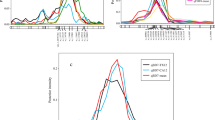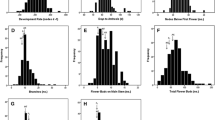Abstract
Fifty-eight F2 individuals derived from an interspecific cross between cultivated eggplant, Solanum melongena, and its wild relative, S. linnaeanum, were phenotyped for 42 plant, leaf, flower, and fruit traits. Composite interval mapping analysis using genotypic data from 736 molecular markers revealed the positions of 71 statistically significant (P ≤ 0.05) quantitative trait loci (QTL) influencing 32 of the morphological traits. Although most QTL were location-specific, QTL governing three traits (leaf lobing, leaf prickles and prickle anthocyanin) were detected in both experimental locations. Analysis of three additional traits (stem prickles, fruit calyx prickles and fruit length) in both locations yielded QTL in similar but non-overlapping map positions. The majority (69 %) of the QTL corresponded closely with those detected in previous analyses of this data set. However the increased resolution of the linkage map combined with advances in QTL mapping permitted more precise localization, such that the average interval length of these QTL was reduced by 93 %. Thirty-one percent of the QTL were novel, suggesting that simple linear regression with a low density linkage map (the method used in previous studies of this population) missed a substantial portion of significant QTL. Hotspots of QTL affecting plant hairiness, prickliness, and pigmentation were identified on chromosomes 3, 6, and 10, respectively, and may reflect the pleiotropic activity of single structural or regulatory genes at these positions. Based on synteny between the eggplant, tomato, potato and pepper genomes, putative orthologs were identified for 35 % of the QTL suggesting strong conservation of gene function within the Solanaceae. These results should make it easier to target particular loci for map-based cloning and marker-assisted selection studies.
Similar content being viewed by others

References
Alpert K, Grandillo S, Tanksley SD (1995) fw2.2: a major QTL controlling fruit weight is common to both red- and green-fruited tomato species. Theor Appl Genet 91:994–1000
Barchi L, Lefebvre V, Sage-Palloix A-M, Lanteri S, Palloix A (2009) QTL analysis of plant development and fruit traits in pepper and performance of selective phenotyping. Theor Appl Genet 118:1157–1171
Barchi L, Lanteri S, Portis E, Vale G, Volante A, Pulcini L, Ciriaci T, Acciarri N, Barbierato V, Toppino L, Rotino GL (2012) A RAD tag derived marker based eggplant linkage map and location of QTLs determining anthocyanin pigmentation. PLoS ONE 7:e43740
Ben Chaim A, Paran I, Grube RC, Jahn M, van Wijk R, Peleman J (2001) QTL mapping of fruit-related traits in pepper (Capsicum annuum). Theor Appl Genet 102:1016–1028
Bonierbale MW, Plaisted RL, Pineda O, Tanksley SD (1994) QTL analysis of trichome-mediated insect resistance in potato. Theor Appl Genet 87:973–987
Busch BL, Schmitz G, Rossmann S, Piron F, Ding J, Bendahmane A, Theres K (2011) Shoot branching and leaf dissection in tomato are regulated by homologous gene modules. Plant Cell 23:3595–3609
Churchill GA, Doerge RW (1994) Empirical threshold values for quantitative trait mapping. Genetics 138:963–971
Clayberg CD (1962) Inheritance and linkage of fruit stripe Fs. Rep Tomato Genet Coop 12:22–23
Collard B, Jahufer M, Brouwer J, Pang E (2005) An introduction to markers, quantitative trait loci (QTL) mapping and marker-assisted selection for crop improvement: the basic concepts. Euphytica 142:169–196
Daunay MC, Aubert S, Frary A, Doganlar S, Lester RN, Barendse G, van der Weerden G, Hennart JW, Haanstra J, Dauphin F, Jullian E (2004) Eggplant (Solanum melongena) fruit colour: pigments measurements and genetics. In: Proceedings of the XIIth EUCARPIA meeting on genetics and breeding of Capsicum and eggplant, 17–19 May 2004, Noordwijkerhout, The Netherlands, pp 108–116
De Jong WS, Eannetta NT, De Jong DM, Bodis M (2004) Candidate gene analysis of anthocyanin pigmentation loci in the Solanaceae. Theor Appl Genet 108:423–432
deVicente MC, Tanksley SD (1993) QTL analysis of transgressive segregation in an interspecific tomato cross. Genetics 134:585–596
Doganlar S, Frary A, Daunay M, Lester R, Tanksley S (2002a) A comparative genetic linkage map of eggplant (Solanum melongena) and its implications for genome evolution in the Solanaceae. Genetics 161:1697–1711
Doganlar S, Frary A, Daunay MC, Lester RN, Tanksley SD (2002b) Conservation of gene function in the Solanaceae as revealed by comparative mapping of domestication traits in eggplant. Genetics 161:1713–1726
Doganlar S, Frary A, Daunay MC, Huvenaars K, Mank R, Frary A (in press) High resolution map of eggplant (Solanum melongena) reveals extensive chromosome rearrangement in domesticated members of the Solanaceae. Euphytica
Eshed Y, Zamir D (1995) An introgression line population of Lycopersicon pennellii in the cultivated tomato enables the identification and fine-mapping of yield-associated QTL. Genetics 141:1147–1162
FAO Statistics (2013) http://faostat.fao.org. Accessed 15 Jan 2013
Frary A, Nesbitt TC, Frary A, Grandillo S, van der Knapp E, Cong B, Liu J, Meller J, Elber R, Alpert KB, Tanskley SD (2000) fw2.2: a quantitative trait locus key to the evolution of tomato fruit size. Science 289:85–88
Frary A, Doganlar S, Daunay MC, Tanksley SD (2003a) QTL analysis of morphological traits in eggplant and implications for conservation of gene function during evolution of Solanaceous species. Theor Appl Genet 107:359–370
Frary A, Doganlar S, Frampton A, Fulton T, Uhlig J, Yates H, Tanksley S (2003b) Fine mapping of quantitative trait loci for improved fruit characteristics from Lycopersicon chmielewskii chromosome 1. Genome 46:235–243
Frary A, Fritz LA, Tanksley SD (2004) A comparative study of the genetic bases of natural variation in tomato leaf sepal and petal morphology. Theor Appl Genet 109:523–533
Fridman E, Liu YS, Carmel-Goren L, Gur A, Shoresh M, Pleban T, Eshed Y, Zamir D (2002) Two tightly linked QTLs modify tomato sugar content via different physiological pathways. Mon Genet Genomics 266:821–826
Fukuoka H, Miyatake K, Nunome T, Negoro S, Shirasawa K, Isobe S, Asamizu E, Yamaguchi H, Ohyama A (2012) Development of gene-based markers and construction of an integrated linkage map in eggplant by using Solanum orthologous (SOL) gene sets. Theor Appl Genet 125:47–56
Grandillo S, Tanksley SD (1996) Analysis of horticultural traits differentiating the cultivated tomato from the closely related species Lycopersicon pimpinellifolium. Theor Appl Genet 92:935–951
Grandillo S, Ku HM, Tanksley SD (1999) Identifying the loci responsible for natural variation in fruit size and shape in tomato. Theor Appl Genet 99:978–987
Hareven D, Gutfinger T, Parnis A, Eshed Y, Lifschitz E (1996) The making of a compound tomato leaf: genetic manipulation of leaf architecture in tomato. Cell 84:735–744
Joehanes R, Nelson JC (2008) QGene 4.0 an extensible Java QTL-analysis platform. Bioinformatics 24:2788–2789
Kimura S, Koenig D, Kang J, Yoong FY, Sinha N (2008) Natural variation in leaf morphology results from mutation of a novel KNOX gene. Curr Biol 18:672–677
Ku H-M, Doganlar S, Chen K-Y, Tanksley SD (1999) The genetic basis of pear-shaped tomato fruit. Theor Appl Genet 9:844–850
Liharska TB, Hontelez J, van Kammen A, Zabel P, Koornneef M (1997) Molecular mapping around the centromere of tomato chromosome 6 using irradiation-induced deletions. Theor Appl Genet 95:969–974
Lippman Z, Tanksley SD (2001) Dissecting the genetic pathway to extreme fruit size in tomato using a cross between the small-fruited wild species Lycopersicon pimpinellifolium and L. esculentum var. Giant Heirloom. Genetics 158:413–422
Liu J, van Eck J, Cong B, Tanksley SD (2002) A new class of regulatory genes underlying the cause of pear-shaped tomato fruit. Proc Natl Acad Sci USA 99:13302–13306
Livingstone KD, Lackney VK, Blauth JR, van Wijk R, Jahn MK (1999) Genome mapping in Capsicum and the evolution of genome structure in the Solanaceae. Genetics 152:1183–1202
Lynch M, Force A (2000) The probability of duplicate gene preservation by subfunctionalization. Genetics 154:459–473
MacArthur JW (1934) Linkage groups in the tomato. J Genet 29:123–133
Maliepaard C, Bas N, van Heusden S, Kos J, Pet G, Verkerk R, Vrielink R, Zabel P, Lindhout P (1995) Mapping of QTLs for glandular trichome densities and Trialeurodes vaporariorum (greenhouse whitefly) resistance in an F2 from Lycopersicon esculentum × Lycopersicon hirsutum f. glabratum. Heredity 75:425–433
Mathews H, Clendennen SK, Caldwell CG, Liu XL, Connors K, Matheis N, Schuster DK, Menasco DJ, Wagoner W, Lightnew J, Wagner DR (2003) Activation tagging in tomato identifies a transcriptional regulator of anthocyanin biosynthesis modification and transport. Plant Cell 15:1689–1703
Monforte A, Friedman E, Zamir D, Tanksley SD (2001) Comparison of a set of allelic QTL-NILs for chromosome 4 of tomato: deductions about natural variation and implications for germplasm collection. Theor Appl Genet 102:572–590
Nagelkerke NJD (1991) A note on a general definition of the coefficient of determination. Biometrika 78:691–692
Nelson JC (1997) QGene: software for marker-based genomic analysis and breeding. Mol Breed 3:229–235
Nunome T, Yoshida T, Hirai M (1998) Genetic linkage map of eggplant. In: Proceedings of the 10th Eucarpia meeting on genetics and breeding of Capsicum and eggplant, Avignon France, pp 239–242
Nunome T, Ishiguro K, Yoshida T, Hirai M (2001) Mapping of fruit shape and color development traits in eggplant (Solanum melongena L.) based on RAPD and AFLP markers. Breed Sci 51:19–26
Paran I, Goldman I, Zamir D (1997) QTL analysis of morphological traits in a tomato recombinant inbred line population. Genome 40:242–248
Powell ALT, Nguyen CV, Hill T, Cheng KL, Figueroa-Balderas R, Aktas H, Ashrafi H, Pons C, Fernandez-Muñoz R, Vicente A, Lopez-Baltazar J, Barry CS, Liu Y, Chetelat R, Granell A, van Deynze A, Giovannoni JJ, Bennett AB (2012) Uniform ripening encodes a Golden 2-like transcription factor regulating tomato fruit chloroplast development. Science 336:1711–1715
Schreiber G, Reuveni M, Evenor D, Oren-Shamir M, Ovadia R, Sapir-Mir M, Bootbool-Man A, Nahon S, Shlomo H, Chen L, Levin I (2012) ANTHOCYANIN1 from Solanum chilense is more efficient in accumulating anthocyanin metabolites than its Solanum lycopersicum counterpart in association with the ANTHOCYANIN FRUIT phenotype of tomato. Theor Appl Genet 124:295–307
Tanksley SD, Ganal MW, de Prince JP, Vicente MC, Bonierbale MW, Broun P, Fulton TM, Giovannoni JJ, Grandillo S, Martin GB, Messeguer R, Miller JC, Miller L, Paterson AH, Pineda O, Roder S, Wing RA, Wu W, Young ND (1992) High-density linkage maps of the tomato and potato genomes. Genetics 132:1141–1160
Tomato Genome Consortium (2012) The tomato genome sequence provides insights into fleshy fruit evolution. Nature 485:635–641
Vales MI, Schon CC, Capettini F, Chen XM, Corey AE, Mather DE, Mundt CC, Richardson KL, Sandoval-Islas JS, Utz HF, Hayes PM (2005) Effect of population size on the estimation of QTL: a test using resistance to barley rust stripe. Theor Appl Genet 111:1260–1270
Voorrips RE (2002) MapChart: software for the graphical presentation of linkage maps and QTLs. J Hered 93:77–78
Wilson LM, Whitt SR, Ibanez AM, Rocheford TR, Goodman MM, Buckler ES (2004) Dissection of maize kernel composition and starch production by candidate gene association. Plant Cell 16:2719–2733
Yates HE, Frary A, Doganlar S, Frampton A, Eannetta N, Uhlig J, Tanksley SD (2004) Comparative fine mapping of fruit quality QTLs on chromosome 4 introgressions derived from two wild tomato species. Euphytica 135:283–296
Zheng ZB (1994) Precision mapping of quantitative trait loci. Genetics 136:1457–1468
Zygier S, Chaim A-B, Efrati A, Kaluzky G, Borovsky Y, Paran I (2005) QTLs mapping for fruit size and shape in chromosomes 2 and 4 in pepper and a comparison of the pepper QTL map with that of tomato. Theor Appl Genet 111:437–445
Acknowledgments
This work was supported by a Career Project (TUBITAK 104T224) from the Scientific and Technical Research Council of Turkey to Sami Doğanlar. This execution of the AFLP marker work was financially supported by DeRuiterZonen C.V., Rijk Zwaan Zaadteelt and Zaadhandel B.V., and Vilmorin Clause & Cie S.A. The AFLP® technology is covered by patents and/or patent applications of Keygene N.V. AFLP and KeyGene are registered trademarks of Keygene N.V. Other trademarks are the property of their respective owners.
Conflict of interest
The authors declare that they have no conflict of interest.
Author information
Authors and Affiliations
Corresponding author
Additional information
The localization of QTL for 32 morphological traits on the high-resolution map of the eggplant genome has allowed hotspots and putative orthologs with other solanaceous species to be identified.
Electronic supplementary material
Below is the link to the electronic supplementary material.
Rights and permissions
About this article
Cite this article
Frary, A., Frary, A., Daunay, MC. et al. QTL hotspots in eggplant (Solanum melongena) detected with a high resolution map and CIM analysis. Euphytica 197, 211–228 (2014). https://doi.org/10.1007/s10681-013-1060-6
Received:
Accepted:
Published:
Issue Date:
DOI: https://doi.org/10.1007/s10681-013-1060-6



